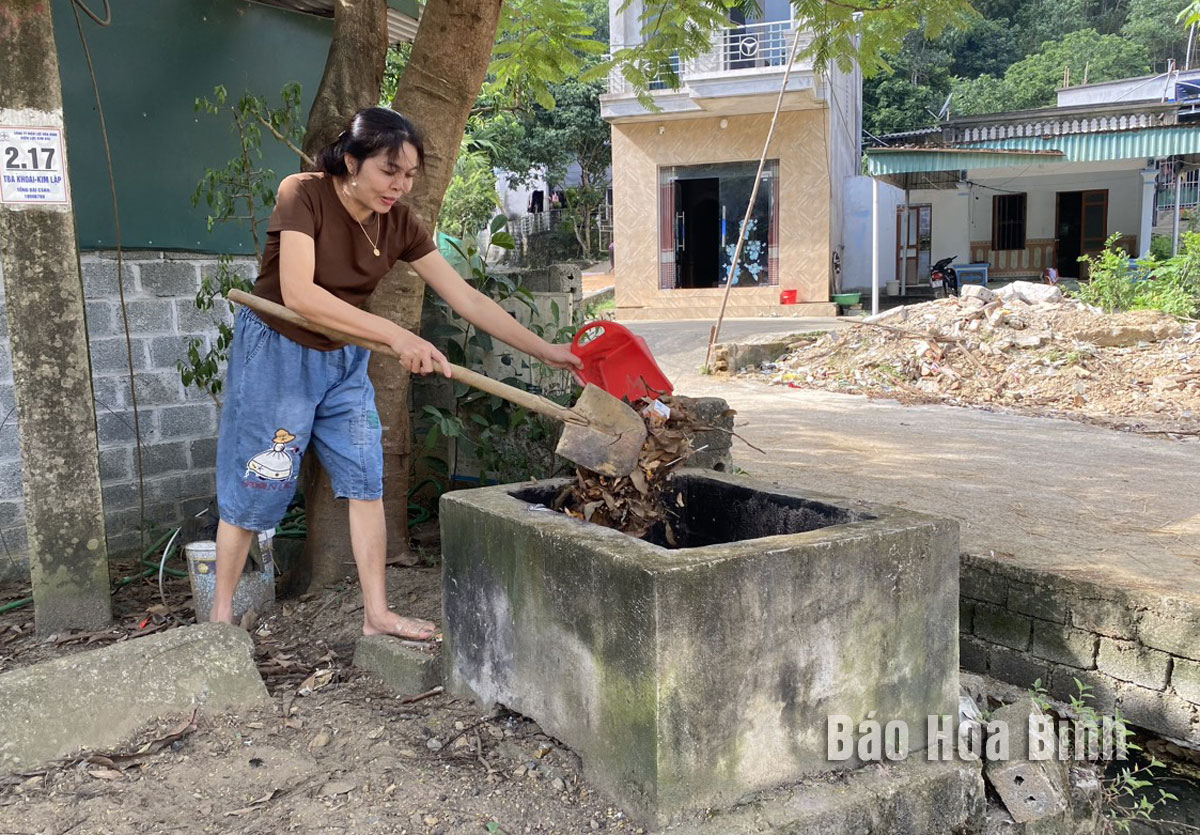
(HBO) - Currently, the implementation of the environment-related criteria in the new-style rural area building programme, particularly rural waste treatment, has received due attention. As building centralised waste treatment areas is not yet possible, building mini brick incinerators at households is a useful model that is proving effective.

A woman in Mo hamlet, Kim Lap commune (Kim Boi), collects and treats garbage at a mini incinerator, contributing to reducing environmental pollution.
Previously, due to living habits, most of the waste of households in Kim Lap commune (Kim Boi) was not treated but mainly thrown into ditches and on streets, causing environmental pollution and adversely affecting people's health. To solve this problem, in 2020, the Kim Lap Farmers' Association disseminated and encouraged locals to build mini trash incinerators at households to collect, process, and limit waste generated into the environment.
Muon is one of the hamlets with the most mini waste incinerators (150). Villagers now no longer see piles of garbage on the roads in the locality. In addition, families are also aware that protecting the environment is a shared responsibility of each person as well as the whole society, so they classify their own waste. Dry garbage is burned in mini incinerators, while fresh garbage that cannot be burned is buried in gardens.
Bui Thi Luc in Muon hamlet shared: "When there was no trash incinerator, every day when I came home from the market, I often threw plastic bags into the garden. Although the family also dug a hole to bury trash in the garden, household waste could not be thoroughly treated. Since the mini waste incinerator was built, there is no longer a situation of littering, the house is clean, the ash from burned garbage and by-products from vegetables and fruits used to compost as fertiliser for plants.”
The building of mini incinerators is simple, easy to implement, and does not take up space, and it can treat household waste on-site, thus helping locals develop a habit of classifying and treating waste on site. In addition, the amount of emissions when burning does not spread to residential areas, so it receives positive response of a large number of people. To date, Kim Lap commune has over 400 brick incinerators built in households, which have initially showed good efficiency of basically solving the amount of waste at home, gradually forming the habit of maintaining hygiene and addressing environmental pollution.
Hoa Binh province is undergoing a dynamic transformation amid Vietnam’s national digital transition. Building on Poliburo’s Resolution No. 57-NQ/TW on breakthroughs in science, technology, innovation, and national digital transformation, the province has rolled out a wide range of practical action plans. A standout initiative is the "Digital Literacy for All” movement, an effort to ensure that no one is left behind in the digital era.
Hoa Binh province is undergoing a dynamic transformation in the wake of the national digital transformation movement. Building on Resolution No. 57-NQ/TW of the Politburo on breakthroughs in science, technology, innovation, and national digital transformation, the province has implemented a wide range of practical action plans. A standout initiative is the "Digital Literacy for All” movement ambitious effort to ensure that no one is left behind in the digital age.
With a spirit of unity and proactive problem-solving, the Party Committee, the government and the people of Dong Lai Commune (Tan Lac District) have made great strides in implementing the resolutions of the 24th Party Congress of the commune for the 2020 - 2025 term. Focusing on leadership and practical actions, the commune has brought the Party’s resolutions into daily life, creating strong impacts and pushing the local development forward.
Amid the nationwide push for digital transformation, young people in Hoa Binh Province are stepping up as dynamic pioneers, applying technology to enhance Youth Union operations and expand the reach of youth-led initiatives. Through creativity and adaptability, Youth Union organizations at all levels have introduced a series of practical solutions, contributing to modern governance and community development.
In recent years, An Nghia commune, located in Lac Son district, has stepped up administrative reform, focusing on improving the quality and efficiency of its single-window service unit for receiving and processing administrative procedures. These improvements have helped create favourable conditions for local residents and organisations to handle administrative procedures, contributing to the commune’s broader socio-economic development.
The Prime Minister-approved master plan to develop the multi-use value of forests ecosystems through 2030, with a vision to 2050, aims to improve the management and sustainable use of forest resources, create jobs, increase incomes, and improve the living standards of ethnic minorities, people in mountainous and remote areas, forest workers and those living near forests.



